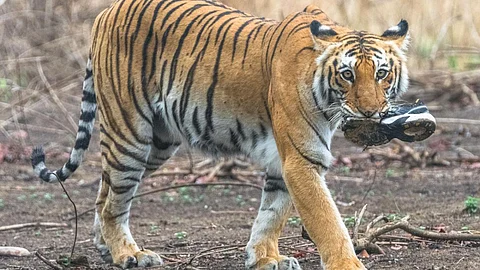
- Topics
- Feature
- Opportunities & Events
- About
- Hindi Portal
- Data
- Topics
- Feature
- Opportunities & Events
- About
- Hindi Portal
- Data

Human-wildlife interaction in India has increasingly become a significant issue, affecting both human populations and wildlife. The growing human population and urban expansion have led to the fragmentation of wildlife habitats, making it difficult for animals to find food and shelter within their natural environments. This challenge is particularly pronounced in regions with high forest cover but also high population densities. Addressing human-wildlife interaction in India requires a multifaceted approach.
A recent roundtable, featuring subject experts and esteemed media representatives, aimed to facilitate a better understanding of the current state of human-wildlife interaction in India, identify existing gaps, and explore potential solutions. The roundtable meeting, titled ‘From conflict to coexistence: Media’s role in shaping public perception on human-wildlife interaction’, was hosted by the ClimateRISE Alliance, Vidhi Centre for Legal Policy, and Mongabay India.
This discussion illuminated the multifaceted impacts of human-wildlife interactions on various stakeholders, shared through stories and case studies from the ground. The roundtable conversation also delved into the reasons behind the increasing incidence of human-wildlife interactions and highlighted the vital role that grassroots civil society organisations (CSOs) play in addressing them.
“The laws and guidelines around handling human-wildlife interactions are clear. Animals such as leopards do not wish to create conflict intentionally, animals are not aware of boundaries, they merely seek safety. There is a need to raise awareness of such issues and the laws surrounding them. The focus must shift towards awareness and capacity building,” said Deboditya Sinha, Lead (Climate & Ecosystems) at the VIDHI Centre for Legal Policy.
The goal of the event was to encourage an enlightening exchange of ideas and experiences on the media's crucial role in shaping key narratives and enhancing public awareness around human-wildlife coexistence. “Reporting on human-wildlife interaction requires very careful handling of hearsay and social media influence to protect all affected parties,” said Ipsita Pati, Times of India.
In contrast, urban populations, who rarely encounter wildlife, often perceive animals as threats. The limited interaction of urban populations with wildlife diminishes their understanding of coexistence, undermining the importance of potential harmonious relationships with wildlife.
Understanding root causes, such as improper waste disposal attracting wildlife, is crucial to addressing these encounters effectively. By distinguishing between benign interactions and true conflicts, we can develop more targeted and effective strategies for coexistence.
Jayashree Nandi from the Hindustan Times also highlighted stories of traditional coexistence efforts practiced by tribal communities in India that have proven successful in managing instances of human-wildlife interaction. Such practices can shift emotional connections between humans and wildlife, facilitating a narrative shift from conflict to interaction and fostering a more harmonious relationship between people and nature.
For instance, labelling indigenous communities as 'encroachers' while not scrutinising urban expansion equally affects policy frameworks and public attitudes. To counteract this, media outlets need to engage in thorough investigation, present balanced viewpoints, and avoid sensationalism. This approach will help build a more informed and empathetic public, better equipped to support effective conservation efforts and coexistence with wildlife.
The language used in these discussions is powerful in shaping narratives. It is crucial to emphasise interaction over conflict and to present diverse narratives with nuance, incorporating India's traditional ideas into mainstream discourse for a more inclusive and constructive dialogue.
At the policy level within the ministry, given the significant issue of human-wildlife interaction, establishing a rapid response team is crucial. Standard Operating Procedures (SOPs) should be developed and implemented at all levels, including schools, panchayats, and particularly in areas prone to leopard encounters.